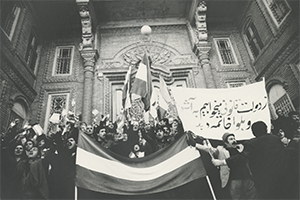
The UCSB Library’s Special Research Collections recently welcomed a deeply personal and historically rich donation from Farrokh Ashti Ashtiani to the U.S. and International History, Politics, Civilization and Cultures Collection. The donation, Ashtiani’s first to UCSB Library, consists of a hand-colored volume of 13th-century Persian poetry, a rare photographic record of the 1979 Iranian Revolution, and a family photo album dating back to the Qajar dynasty (1789–1925). The items reflect generations of cultural memory and a thoughtful commitment to preservation and public access.
"I initially explored museum donations," Ashtiani explained. "But while museums preserve materials well, access can be limited. Universities like UCSB offer broader access for global researchers. A university library is an ideal custodian for items of personal and historical significance."
At the heart of the donation is a volume of poetry by the celebrated Persian poet Saadi Shirazi (1209/1210–1291/1292), printed during the reign of Nasseredin Shah Qajar (1848–1896). Saadi is widely recognized as one of the greatest poets of classical Persian literature. The book belonged to Ashtiani’s grandfather, Nasrollah Ashtiani, who was a Mostofian (مستوفیان)—a court official responsible for literature, finance, and recordkeeping—and served as superintendent of Shahabad Palace during the reigns of four Qajar kings.
In the quiet evenings, under the glow of an oil lamp, Nasrollah Ashtiani painted delicate watercolors directly into the book. These illustrations not only enhance its visual beauty but also imbue it with a layer of personal expression and care that has endured through generations. "This book carries deep personal and cultural meaning," Farrokh Ashtiani shared, "which is why I wanted it preserved in a place where it will endure."
 The second item is a compelling photographic album that Ashtiani compiled during the Iranian Revolution. What began as a short trip to Iran in 1978 turned into a yearlong journey documenting the revolution as it unfolded. With three Nikon cameras in hand, he captured the energy and uncertainty of the streets—some of his photographs were later published in the Dallas Times Herald. "Every successful shutter click felt like doing something meaningful for posterity," he recalled.
The second item is a compelling photographic album that Ashtiani compiled during the Iranian Revolution. What began as a short trip to Iran in 1978 turned into a yearlong journey documenting the revolution as it unfolded. With three Nikon cameras in hand, he captured the energy and uncertainty of the streets—some of his photographs were later published in the Dallas Times Herald. "Every successful shutter click felt like doing something meaningful for posterity," he recalled.
The third item, a family photo album dating back to the 1890s, includes formal portraits of Qajar royalty and dignitaries, letterheads from Shahabad Palace, and views of the palace that no longer exist. Among its rare images is the only known childhood photograph of Ahmad Shah Qajar (1898–1930), the last ruler of the Qajar dynasty. The album also features images of Nasrollah Ashtiani hosting guests in the palace garden, surrounded by the sycamore trees he planted—many of which still stand today. Farrokh Ashtiani safeguarded the album for over five decades, even carrying it to safety during Santa Barbara’s 2008 Tea Fire.
 Ashtiani came to the United States as a college student in June 1970 and pursued his education at the University of Texas and George Mason University in Virginia, focusing on finance. After a career in finance that included serving as Chief Financial Officer for two tech startups in Santa Barbara, he retired following the sale of both companies. He has lived in Santa Barbara since 1995.
Ashtiani came to the United States as a college student in June 1970 and pursued his education at the University of Texas and George Mason University in Virginia, focusing on finance. After a career in finance that included serving as Chief Financial Officer for two tech startups in Santa Barbara, he retired following the sale of both companies. He has lived in Santa Barbara since 1995.
"The collection makes three valuable and unique historical resources available for research and teaching at UCSB as well as for the broader local, national, and international community of researchers," said Yolanda Blue, the Library’s Curator of U.S. and International History, Politics, Civilization and Cultures.
Image Captions
- Close-up of pages in the book of Saadi Shirazi's poetry.
- Group of protesters during the Iranian Revolution, 1978/1979.
- Child standing on a toppled statue during the Iranian Revolution, 1978/1979.


